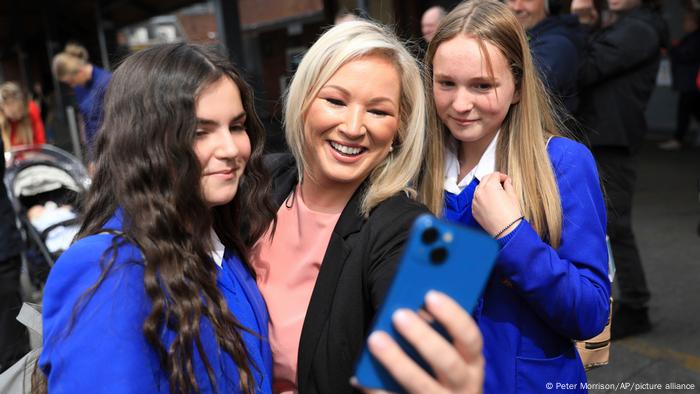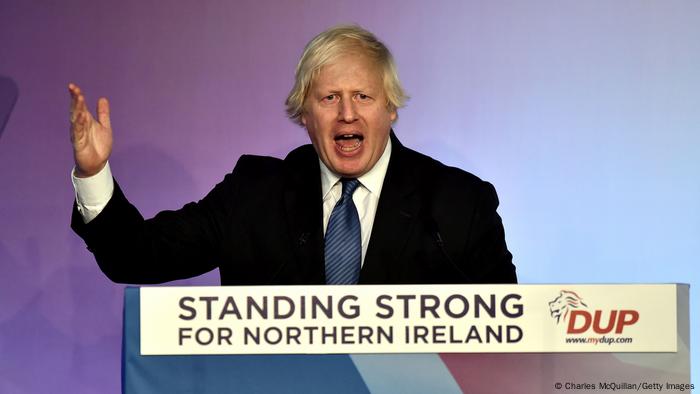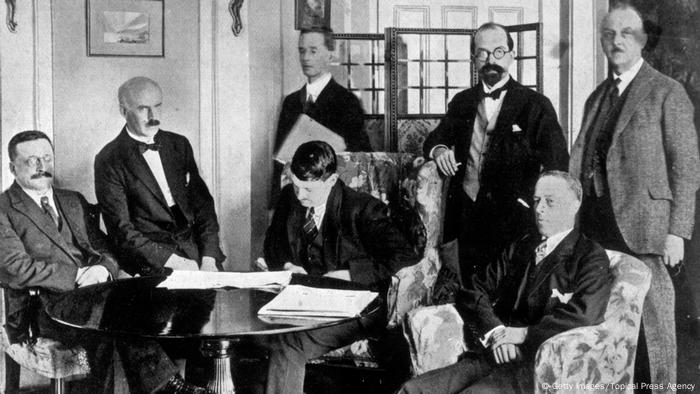For the first time, a nationalist party has become the strongest party in the Northern Ireland Assembly.
What does Sinn Fein stand for?
And what could this result mean for the future?

Sinn Fein candidate Michelle O'Neill celebrated her party's likely victory on election night
Sinn Fein, which seeks to reunite Northern Ireland with the Republic of Ireland, emerged ahead of the pack after Friday's election. As vote counting neared completion late Saturday, the BBC reported that the party had captured at least 27 of the 90 seats in the Northern Ireland Assembly. The pro-Britain Democratic Unionist Party (DUP) was set for 24. The Alliance Party, which is not affiliated with either of the two main parties but aims to bridge partisan differences, was in third, with 17.
The majority Catholic Sinn Fein would like to dissolve Northern Ireland's ties to the United Kingdom, where it is a constituent region alongside England, Scotland and Wales, and unify with its EU neighbor to the south, the Republic of Ireland. Its strongest rival, the Protestant DUP, fundamentally opposes this.
For many years, Northern Ireland experienced what is known as "the troubles," a conflict between pro-Britain unionists and Irish nationalists that left more than 3,500 people dead. In 1998, after over 30 years of fighting, the conflict formally came to an end with the signing of the Good Friday Agreement.
Sinn Fein was long considered the political arm of the Irish Republic Army, which the United Kingdom classified as a terrorist organization. In summer 2005, seven years after the Good Friday peace deal, the IRA ended its armed struggle.

Sinn Fein candidate Michelle O'Neill celebrated her party's likely victory on election night
Sinn Fein, which seeks to reunite Northern Ireland with the Republic of Ireland, emerged ahead of the pack after Friday's election. As vote counting neared completion late Saturday, the BBC reported that the party had captured at least 27 of the 90 seats in the Northern Ireland Assembly. The pro-Britain Democratic Unionist Party (DUP) was set for 24. The Alliance Party, which is not affiliated with either of the two main parties but aims to bridge partisan differences, was in third, with 17.
The majority Catholic Sinn Fein would like to dissolve Northern Ireland's ties to the United Kingdom, where it is a constituent region alongside England, Scotland and Wales, and unify with its EU neighbor to the south, the Republic of Ireland. Its strongest rival, the Protestant DUP, fundamentally opposes this.
For many years, Northern Ireland experienced what is known as "the troubles," a conflict between pro-Britain unionists and Irish nationalists that left more than 3,500 people dead. In 1998, after over 30 years of fighting, the conflict formally came to an end with the signing of the Good Friday Agreement.
Sinn Fein was long considered the political arm of the Irish Republic Army, which the United Kingdom classified as a terrorist organization. In summer 2005, seven years after the Good Friday peace deal, the IRA ended its armed struggle.

The IRA led a violent campaign for Irish unification over decades
Sinn Fein's charismatic leading candidate, Michelle O'Neill, is in large part responsible for the party's electoral success. Instead of dredging up Northern Ireland's painful history, the 45-year-old focused on voters' everyday worries. O'Neill came off as grounded, and she presented herself as the candidate who would represent the interests of Northern Ireland. She promised to resolve pressing problems in health care and help people affected by rising prices.
Nevertheless, Northern Ireland's history also cast a shadow over her campaign. Two of her cousins were members of the IRA. One, Tony Doris, was killed by the British Army's Special Air Service in the 1991 Coagh ambush; the other, Gareth Malachy Doris, was wounded by the SAS in the 1997 Coalisland attack and imprisoned after surgery before being released under the terms of the Good Friday Agreement in 2000. Her father, Brendan Doris, a Sinn Fein politician, was also jailed more than once for his IRA connections.

Michelle O'Neill helped lead the Sinn Finn party toward victory
Brexit weakened DUP
Sinn Fein was helped in the election by a weakened DUP. Since 2000, the pro-Britain party won every parliamentary election, peaking at about 30% support. But the UK's Brexit decision largely upset the status quo. The Northern Ireland Protocol, which regulates trade between the islands of Great Britain and Ireland, is a particular point of contention. In order to avoid a hard border between the Republic of Ireland and Northern Ireland, it was determined that a border should be drawn in the sea between the islands. This allows for the free movement of goods on the island. At the same time, Northern Ireland needs to abide by many EU conditions, even when the incoming goods originate in Great Britain. Many unionists are disappointed that the protocol creates a divide with London.
NORTHERN IRELAND'S CHANGING BORDERThe Irish Free StateBritain's response to Irish demands for independence was devolution within the UK, or home rule. Pro-British Unionists didn't want to be governed by Dublin, so two parliaments were set up, for Northern and Southern Ireland. However, nationalists still pushed for full independence and in 1922 Southern Ireland was superseded by the Irish Free State as enshrined in the Anglo-Irish Treaty (pictured).
It is unlikely that Sinn Fein's victory will lead to Northern Ireland's quick reunification with the Republic of Ireland. It is generally thought that the party will push for a referendum on the issue so that the residents of Northern Ireland can decide whether they want unification. However, for various reasons, this will take time.
According to the terms of the Good Friday Agreement, the power to call a referendum lies with the UK government. A successful outcome cannot be directly inferred from the result of the election. Currently, only one-third of people in Northern Ireland support reunification and only one-sixth consider it to be a political priority.

Johnson, who is seen here at a DUP conference in 2018, supports the unionist party
Government deadlock expected
The Good Friday Agreement also stands in the way of any quick changes when it comes to forming a government. With its likely victory, Sinn Fein has the right to form a government with lead candidate O'Neill as first minister. However, the terms of the peace agreement require O'Neill to have a deputy minister from the DUP who is equally empowered.
Additionally, the nonaffiliated Alliance Party will likely drag out government negotiations. This is because the Good Friday Agreement does not provide for a strong neutral party in Northern Ireland's power-sharing system. Perhaps unsurprisingly, the Alliance would like to reform the entire agreement.

Brexit disruptions led to empty shelves in supermarkets, such as in Belfast in 2021
The three top parties are unlikely to agree on much. The nationalist Sinn Fein is pushing for a referendum and has no interest in getting rid of the divisive Northern Ireland protocol. The DUP supports exactly the opposite. The Alliance wants to do away with the dualistic system that favors both other parties.
So, despite Sinn Fein's pending historic victory, Belfast is likely headed toward political stalemate. Such an uncertain situation is not unusual in Northern Ireland, however. The constitution already provides a solution: If the government is incapable of acting, London can impose direct rule in the meantime.
This article was originally written in German.












